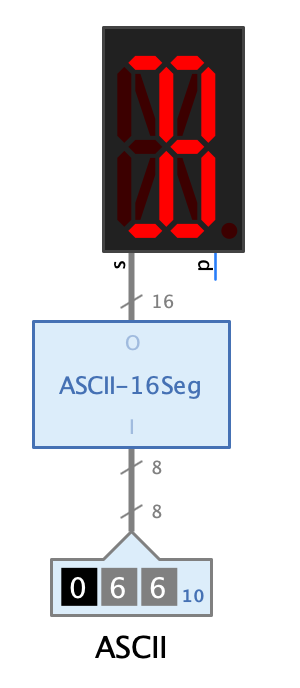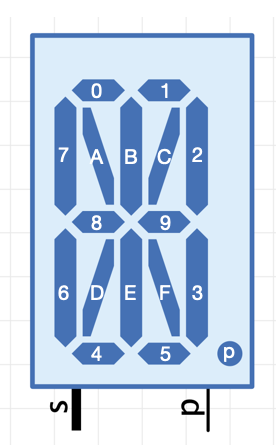Appearance

Behaviour
The 16-segment display contains 16 LEDs arranged in the form of a digit or character and one LED at the bottom right, which is used as a dot. The LEDs light up depending on the signals applied to the inputs. If a 0 is present, the LEDs are drawn in the dark representation of the selected light color. If a 1 is present, the bright representation of the light color is used.
Each of the 16 bits of input "S" is mapped to an individual LED as indicated in the image below (hexadecimal numbering).

The standard library contains an "ASCII-16 Segment Decoder" that decodes ASCII encoded characters to the corresponding 16-Segment code. It supports codes for the following ASCII characters:
ASCII Codes |
Characters |
0..15 |
Hexadecimal digits |
34,36,37,39,40,41,42,43,44,45,47 |
Special characters |
48..57 |
Decimal digits |
61 |
Special character |
65..90 |
Uppercase letters |
91,92,93,95 |
Special characters |
97..122 |
Lowercase letters displayed as uppercase |
123..125 |
Special characters |
Pins
- p
-
Controls the decimal point
- s
-
Accepts an 16-bit value whose bits control the 16 segments of the display.
Properties
- LED color
-
The color of the LEDs. The menu offers all light colors implemented in Antares for selection.
- Active
-
"Positive" turns LEDs on with 1, "Negative" with 0.
- Size
-
The 16-segment display can be displayed in the three sizes "large", "medium" and "small".
- Border
-
If not set, the display is drawn without a border, which can be useful for building areas of multiple displays.